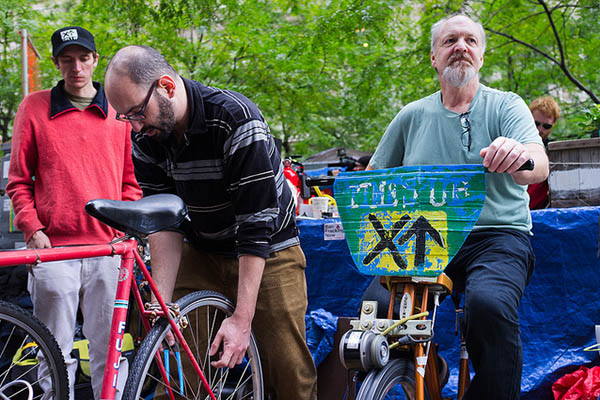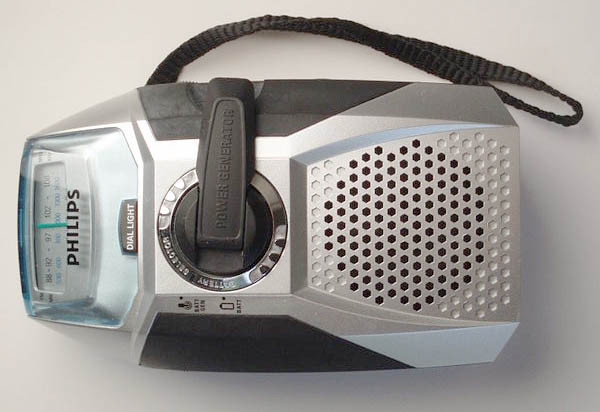Generating electricity isn’t limited to burning things, making steam, or harnessing the power of wind, wave, and sun—even though these are by far the most common ways of doing so. Delving into the more obscure, you’ve no doubt seen people peddling a stationary bicycle to power some lightbulbs; and you may have a crank-powered emergency radio or flashlight in a drawer someplace. But did you know that companies have tried and are trying to generate power from people jumping around and dancing in clubs, and even by them them just walking down the street?

All are technically possible, for sure. The technology isn’t crackpot. But against the backdrop of the massive amounts of energy we use, that we need to start generating from non-polluting sources (and now!), are any of these forms of renewable energy really worth the effort?
Let’s take a look.
Pedal-Powered Devices
For well over the past hundred years there have been pedal-powered machines, using something approaching what we’d today easily identify as parts of a bicycle. If we include treadle-powered and hand crank machines, the history of humans taking advantage of gears, cranks, and levers to boost the ability of machines to do work is much much older—for the past millennium at least.
From the 1870s through the turn of the 20th century the number of pedal-powered machines was astounding, and very, very efficient in many ways. In fact, much more efficient in many applications than generating electricity through pedal power.
As far as using pedal-power to generate electricity, these machines have a much less old pedigree, dating back to the 1970s. In the past several years they’ve certainly risen in popularity: During the COP15 climate talks there was a large array of them in Copenhagen demonstrating the potential of moving legs and pumping hearts to light up a Christmas tree. During the Occupy Wall Street protests in lower Manhattan, when the police pulled the power running into Zuccotti Park, activists rigged together several energy bikes to keep the electricity running.

Bicycle-powered generators work. They can be made from essentially scrounged parts. They definitely have a certain allure to them, a certain deep DIY sensibility. But they are unfortunately seriously inefficient when it comes to generating electricity.
Low-tech Magazine has a superb take-down of them, highlighting how the efficiency of these machines drops (and drops, and drops) every step of the way.
Here’s the gist of it: 1) Do to internal energy losses and inefficiencies, if the legs are capable of generating say 100 watts of power, well of half of that gets thrown away just converting the motion of your legs to electricity. 2) Because most of these use an ordinary bicycle just hooked up to a stand, the friction drive that connects them drops the efficiency of the system even more. 3) Due to the position of the rider on the bike leaning forward, in most bikes used for these devices, there are further efficiency losses—what’s good for aerodynamics going down the road isn’t as good for generating electricity.
That’s just generating the electricity. Once you take into account that the battery hooked up to it has a good deal of embodied energy in it, the conclusion of Low-tech Mag that you’re essentially just pedaling to pay back the energy needed to make the battery really takes the air out of the tires of these systems.
For most uses that is. In quasi-emergency situations, such as the OWS protests or perhaps in disaster situations, where you have no other way of generating electricity, there may be so good sense in getting on the energy bike.
But as part of the bigger picture of an all-renewable energy future, this is a teeny tiny niche application. In fact, if people want to burn calories to power machines, it’d be far better to do it directly, like our great-great grandparents’ generation did.
Crank-Powered Devices
Crank-powered radios date back to World War 2, with flashlights being a more recent invention. They work on the same basic plan as a energy bike, albeit in a much more contained, less Rube Goldberg-esque, package. The simply convert the mechanical power from your muscles turning the handle into electricity that’s stored for a time in the radio or flashlight.
Not that much electricity can be generated this way, but in the application they are designed for (and in comparison to energy bikes) these can make a lot of sense environmentally. Rather than having your emergency radio or light powered by disposable batteries (a waste issue as well as having extra embodied energy to repay), you probably always have another minute of cranking in you.

I used a crank-powered flashlight in the aftermath of Hurricane Sandy when my apartment was without electricity and the basement flooded and, while not in any sense a literal lifesaver in my case, it certainly made life much easier. I now have a crank-powered radio as well, with the ability to charge anything that can hook up to it via USB cable. I’m not sure how well the USB charging will work, but in the sort of situation this sort of device is designed for, it likely works well enough.
Outside of their intended emergency application, crank-powered devices can still serve an important function in places where there is no grid access currently (or perhaps ever) and where solar panels or other renewable electricity sources are well out of financial reach.
As for making a meaningful contribution to weaning the world off fossil fuels though, this isn’t the way to go.
The Electric Dance Floor
While the previous two examples are have solid (if small) commercial representation, we now start venturing into the realm of the technically possible but gimmicky and borderline absurd.
Going back to 2008, at the height of the Green New Wave, the Evening Standard highlight what promised to be Britain’s first eco-nightclub, Surya. What made it so eco-friendly wasn’t solely the provenance of its drinks, though everything was touted as organic, but rather its energy-generating dance floor.
The club is still there, with eco-credentials intact, but the people-powered dance floor doesn’t seem to have ever come to pass.
It would have worked like this: The floor would have springs and piezoelectric power generating blocks underneath it. As patrons dance, moving up and down, the blocks generate small amounts of power, charging batteries which are then used to power parts of the club.
More recently, in 2011 San Francisco’s Temple Nightclub tried a similar thing—and appears to have pulled it off, for a weekend. Over 10 hours of dancing 480 watts were generated, by 1400 people. It was no doubt a noble effort, but that’s a miniscule amount of electricity really.
It’s an interesting idea, but it’s a token nod towards sustainability in any deep sense.
Electric Sidewalks
The same basic idea is taken to a different scale, albeit one not yet implemented, but the folks at The Facility. Writing in The Atlantic, here’s Emily Badger:
“‘At the moment,’ says Oliver Schneider, the managing director of London-based architecture and innovation consultancy The Facility, ‘when you walk along the ground, the energy that you’re giving out actually goes into the ground as vibration through the body, as sound, as friction that wears your shoes out.’
Picture a whole crowd of pedestrians scuffing their soles and stomping to work – maybe on a subway platform, or in food court – and that accumulated footfall starts to look like something that might be useful. The Facility has been working on variations of this notion for a decade, harnessing energy from foot traffic, from cars rolling over roadways, or trains rumbling across railroad tracks. And as long as we’re looking for renewable energy just about anywhere we can find it, why not literally beneath our feet?”
Again, it’s a somewhat intriguing idea, but it falls apart when you consider how infrastructure takes a beating in any urban area with sufficient density and foot traffic to even have a snowball’s chance in an increasingly warming planet to ever pay off the embedded energy of such a system.
Putting solar panels on every building abutting the sidewalk would be a far, far better use of resources. Leave the sidewalks be and generate power elsewhere.